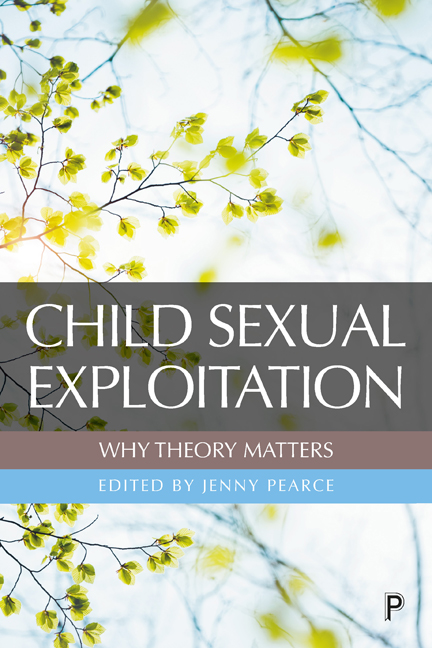Book contents
- Frontmatter
- Contents
- List of Figures and Tables
- Notes on Contributors
- Editor’s Acknowledgements
- Foreword
- 1 Bringing Theory Home: Thinking About Child Sexual Exploitation
- 2 Moving Beyond Discourses of Agency, Gain and Blame: Reconceptualising Young People’S Experiences of Sexual Exploitation
- 3 Child Sexual Exploitation, Discourse Analysis and why we Still Need to Talk About Prostitution
- 4 Contextual Safeguarding: Theorising the Contexts of Child Protection and Peer Abuse
- 5 ‘Losing Track of Morality’: Understanding Online Forces and Dynamics Conducive to Child Sexual Exploitation
- 6 Understanding Adolescent Development in the Context of Child Sexual Exploitation
- 7 Some Psychodynamic Understandings of Child Sexual Exploitation
- 8 Understanding Trauma and its Relevance to Child Sexual Exploitation
- 9 Social Support, Empathy and Ecology: A Theoretical Underpinning for Working with Young People who have Suffered Child Sexual Abuse or Exploitation
- 10 Using an Intersectional Lens to Examine the Child Sexual Exploitation of Black Adolescents
- 11 What’s Gender Got to do With It? Sexual Exploitation of Children as Patriarchal Violence
- 12 Understanding Models of Disability to Improve Responses to Children with Learning Disabilities
- 13 Some Concluding Thoughts
- Index
3 - Child Sexual Exploitation, Discourse Analysis and why we Still Need to Talk About Prostitution
Published online by Cambridge University Press: 10 March 2021
- Frontmatter
- Contents
- List of Figures and Tables
- Notes on Contributors
- Editor’s Acknowledgements
- Foreword
- 1 Bringing Theory Home: Thinking About Child Sexual Exploitation
- 2 Moving Beyond Discourses of Agency, Gain and Blame: Reconceptualising Young People’S Experiences of Sexual Exploitation
- 3 Child Sexual Exploitation, Discourse Analysis and why we Still Need to Talk About Prostitution
- 4 Contextual Safeguarding: Theorising the Contexts of Child Protection and Peer Abuse
- 5 ‘Losing Track of Morality’: Understanding Online Forces and Dynamics Conducive to Child Sexual Exploitation
- 6 Understanding Adolescent Development in the Context of Child Sexual Exploitation
- 7 Some Psychodynamic Understandings of Child Sexual Exploitation
- 8 Understanding Trauma and its Relevance to Child Sexual Exploitation
- 9 Social Support, Empathy and Ecology: A Theoretical Underpinning for Working with Young People who have Suffered Child Sexual Abuse or Exploitation
- 10 Using an Intersectional Lens to Examine the Child Sexual Exploitation of Black Adolescents
- 11 What’s Gender Got to do With It? Sexual Exploitation of Children as Patriarchal Violence
- 12 Understanding Models of Disability to Improve Responses to Children with Learning Disabilities
- 13 Some Concluding Thoughts
- Index
Summary
Introduction
A critique is not a matter of saying that things are not right as they are. It is a matter of pointing out on what kinds of assumptions, what kinds of familiar, unchallenged, unconsidered modes of thought the practices that we accept rest. (Foucault 1988:155)
It is nearly 20 years since the UK started ‘doing something’ about child sexual exploitation (CSE). From our vantage point of the early twenty-first century, it seems self-evidently true that CSE is a form of child sexual abuse (CSA) and, as such, statutory social services (and the police) are the best agencies to deal with it. It also seems self-evident that social work professional knowledge and expertise is required in order to assess individual cases, understand the aetiology of CSE and individual's circumstances, devising and managing programmes of intervention that will produce the best possible outcome for the abused child.
If we scratch below these taken-for-granted truths, though, we may see that our contemporary practices rest on what is, in effect, certain ‘unsayable’ things. What is ‘normal’ adolescent behaviour? How is it shaped by wider social structures of race, gender, ability and age-based inequalities? What are the connections between CSE and prostitution? They may be ‘unsayable’ because the assumptions we work with seem in themselves ‘self-evident’ (the difference between ‘normal’ and ‘not normal’). They may be unsayable because of the way that we define and act upon CSE. As CSE is currently constituted, to acknowledge that there might be a connection between CSE and prostitution is seen as implying that the children harmed have somehow, in some way, consented to their harm.. Yet, these ‘discursive erasures’ have not always existed. The connections were once acknowledged, understood and discussed without the sole recourse being to statutory social services and child protection practices and without anyone denying the harm and damage that was done to young people.
This chapter provides a discourse analysis of the emergence of CSE as a social problem in order to uncover the unchallenged modes of thought that dominate our practices and assumptions about what CSE is and how to deal with it. The first section describes discourse analysis and suggests the sort of questions that such an approach raises. The second section describes the discursive field out of which emerged the discourse of CSE as a particular type of social problem.
- Type
- Chapter
- Information
- Child Sexual Exploitation: Why Theory Matters , pp. 43 - 62Publisher: Bristol University PressPrint publication year: 2019



